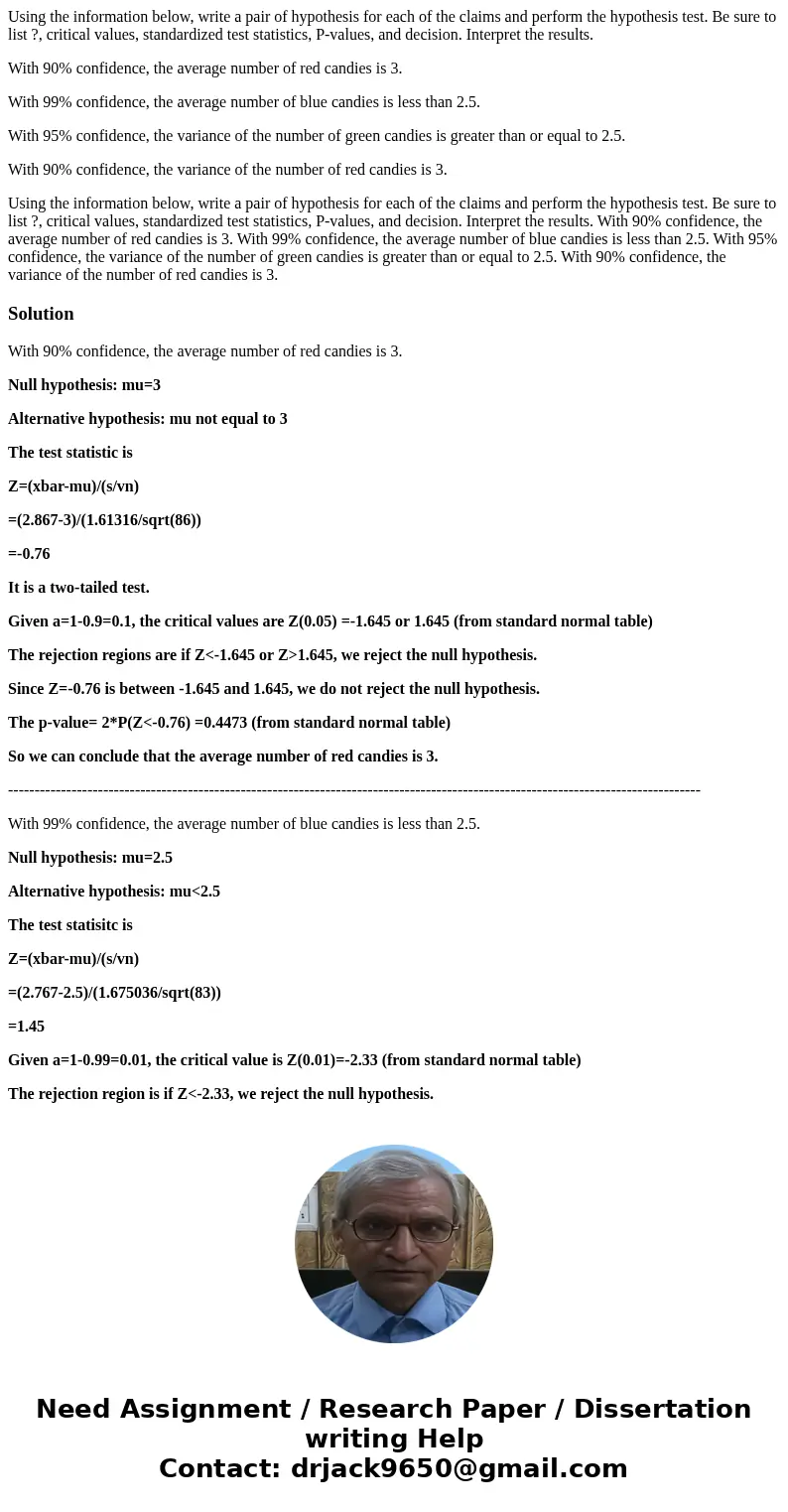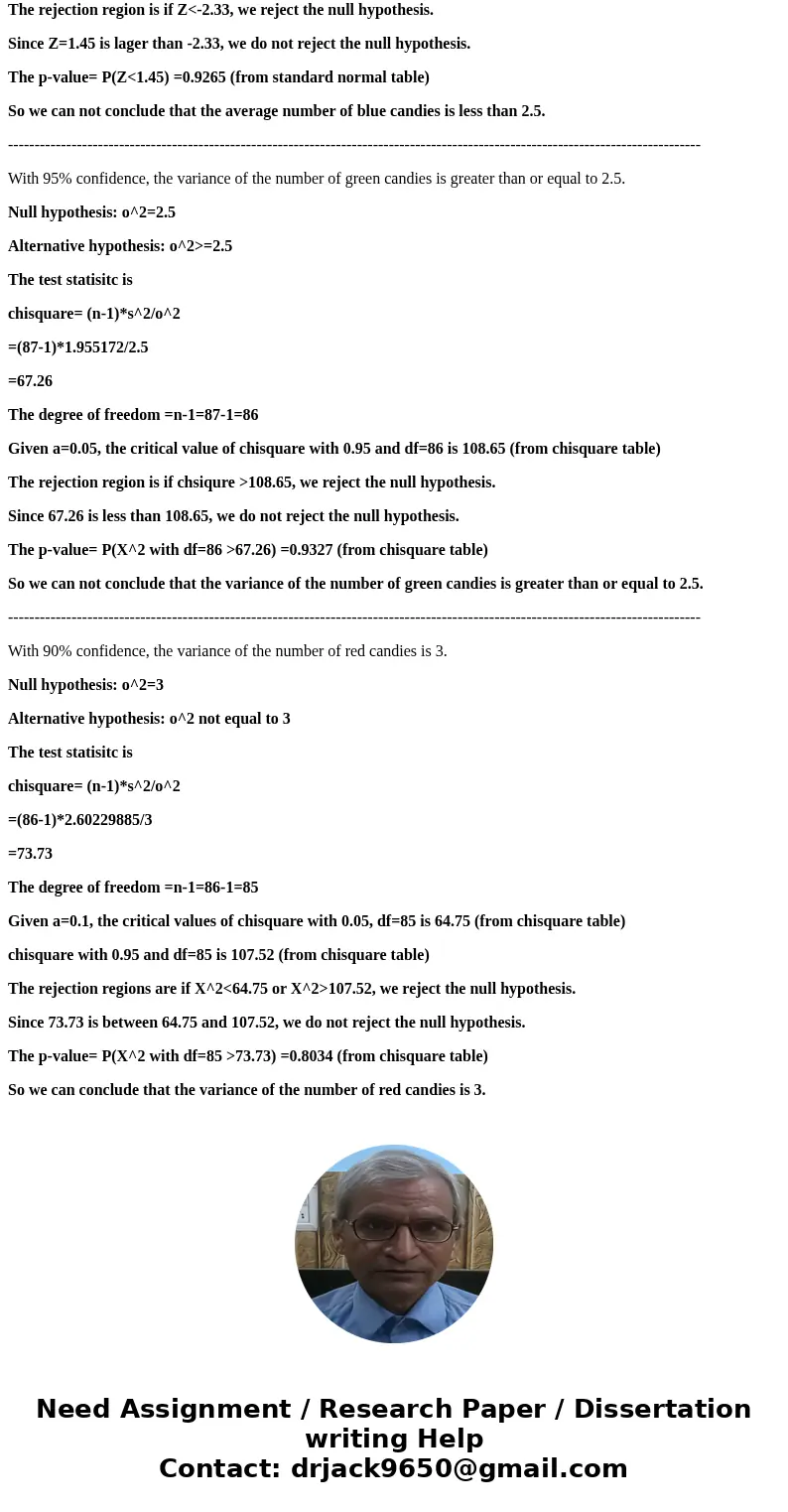Using the information below write a pair of hypothesis for e
Using the information below, write a pair of hypothesis for each of the claims and perform the hypothesis test. Be sure to list ?, critical values, standardized test statistics, P-values, and decision. Interpret the results.
With 90% confidence, the average number of red candies is 3.
With 99% confidence, the average number of blue candies is less than 2.5.
With 95% confidence, the variance of the number of green candies is greater than or equal to 2.5.
With 90% confidence, the variance of the number of red candies is 3.
Using the information below, write a pair of hypothesis for each of the claims and perform the hypothesis test. Be sure to list ?, critical values, standardized test statistics, P-values, and decision. Interpret the results. With 90% confidence, the average number of red candies is 3. With 99% confidence, the average number of blue candies is less than 2.5. With 95% confidence, the variance of the number of green candies is greater than or equal to 2.5. With 90% confidence, the variance of the number of red candies is 3.Solution
With 90% confidence, the average number of red candies is 3.
Null hypothesis: mu=3
Alternative hypothesis: mu not equal to 3
The test statistic is
Z=(xbar-mu)/(s/vn)
=(2.867-3)/(1.61316/sqrt(86))
=-0.76
It is a two-tailed test.
Given a=1-0.9=0.1, the critical values are Z(0.05) =-1.645 or 1.645 (from standard normal table)
The rejection regions are if Z<-1.645 or Z>1.645, we reject the null hypothesis.
Since Z=-0.76 is between -1.645 and 1.645, we do not reject the null hypothesis.
The p-value= 2*P(Z<-0.76) =0.4473 (from standard normal table)
So we can conclude that the average number of red candies is 3.
-----------------------------------------------------------------------------------------------------------------------------------
With 99% confidence, the average number of blue candies is less than 2.5.
Null hypothesis: mu=2.5
Alternative hypothesis: mu<2.5
The test statisitc is
Z=(xbar-mu)/(s/vn)
=(2.767-2.5)/(1.675036/sqrt(83))
=1.45
Given a=1-0.99=0.01, the critical value is Z(0.01)=-2.33 (from standard normal table)
The rejection region is if Z<-2.33, we reject the null hypothesis.
Since Z=1.45 is lager than -2.33, we do not reject the null hypothesis.
The p-value= P(Z<1.45) =0.9265 (from standard normal table)
So we can not conclude that the average number of blue candies is less than 2.5.
-----------------------------------------------------------------------------------------------------------------------------------
With 95% confidence, the variance of the number of green candies is greater than or equal to 2.5.
Null hypothesis: o^2=2.5
Alternative hypothesis: o^2>=2.5
The test statisitc is
chisquare= (n-1)*s^2/o^2
=(87-1)*1.955172/2.5
=67.26
The degree of freedom =n-1=87-1=86
Given a=0.05, the critical value of chisquare with 0.95 and df=86 is 108.65 (from chisquare table)
The rejection region is if chsiqure >108.65, we reject the null hypothesis.
Since 67.26 is less than 108.65, we do not reject the null hypothesis.
The p-value= P(X^2 with df=86 >67.26) =0.9327 (from chisquare table)
So we can not conclude that the variance of the number of green candies is greater than or equal to 2.5.
-----------------------------------------------------------------------------------------------------------------------------------
With 90% confidence, the variance of the number of red candies is 3.
Null hypothesis: o^2=3
Alternative hypothesis: o^2 not equal to 3
The test statisitc is
chisquare= (n-1)*s^2/o^2
=(86-1)*2.60229885/3
=73.73
The degree of freedom =n-1=86-1=85
Given a=0.1, the critical values of chisquare with 0.05, df=85 is 64.75 (from chisquare table)
chisquare with 0.95 and df=85 is 107.52 (from chisquare table)
The rejection regions are if X^2<64.75 or X^2>107.52, we reject the null hypothesis.
Since 73.73 is between 64.75 and 107.52, we do not reject the null hypothesis.
The p-value= P(X^2 with df=85 >73.73) =0.8034 (from chisquare table)
So we can conclude that the variance of the number of red candies is 3.


 Homework Sourse
Homework Sourse